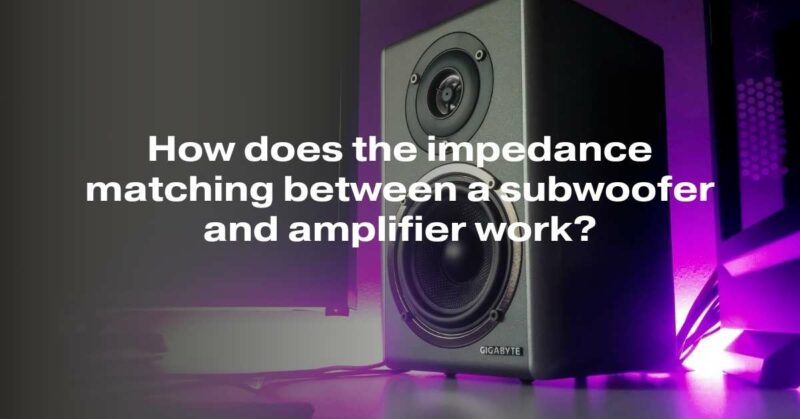When it comes to building a high-quality audio system, one of the crucial aspects to consider is impedance matching between your subwoofer and amplifier. Proper impedance matching ensures that your audio components work harmoniously, delivering optimal performance and preventing potential damage. In this article, we will delve into the world of audio impedance and explore how impedance matching affects the performance of subwoofers and amplifiers.
- What is Impedance?
Impedance, often denoted by the symbol “Z,” is a fundamental electrical property in audio systems. It measures the opposition a component offers to the flow of alternating current (AC). Impedance consists of two components: resistance (R) and reactance (X). Resistance is the opposition to the flow of direct current (DC), while reactance represents the opposition to the flow of AC due to factors like inductance and capacitance.
In audio systems, impedance is typically measured in ohms (Ω) and plays a pivotal role in determining how efficiently power is transferred from the amplifier to the subwoofer.
- The Importance of Impedance Matching
Impedance matching ensures that the subwoofer and amplifier are compatible with each other, optimizing power transfer and preventing overheating or damage. A well-matched system will deliver cleaner, distortion-free audio and prolong the lifespan of your equipment. Here’s how impedance matching works in the context of subwoofers and amplifiers:
- Subwoofer Impedance
Subwoofers come in various impedance ratings, commonly 2, 4, or 8 ohms. The impedance rating indicates how much resistance the subwoofer presents to the amplifier. For instance, a 4-ohm subwoofer will draw more current from the amplifier than an 8-ohm subwoofer at the same voltage. This increased current can lead to higher sound output but may also require an amplifier that can handle the load.
- Amplifier Impedance
Amplifiers are designed to work with specific impedance ranges, and these ranges are often denoted on the amplifier’s specification sheet. For example, an amplifier might be rated to work with speakers and subwoofers that have an impedance between 4 to 8 ohms. Using an amplifier with an impedance rating outside its specified range can result in poor performance or even damage to the amplifier.
- Matching Impedance
To achieve optimal impedance matching between your subwoofer and amplifier, follow these steps:
a. Check the specifications: Review the impedance ratings of both your subwoofer and amplifier. Ensure that they fall within the specified ranges.
b. Match or exceed the amplifier’s minimum impedance: If your amplifier provides a minimum impedance rating, choose a subwoofer with an equal or higher impedance. This ensures safe operation and prevents overloading the amplifier.
c. Series and parallel connections: In some cases, you may need to use series or parallel connections to achieve the desired impedance. Series connections add the impedance of components (e.g., two 4-ohm subwoofers in series result in an 8-ohm load), while parallel connections decrease impedance (e.g., two 4-ohm subwoofers in parallel result in a 2-ohm load). Be cautious when using parallel connections, as they can significantly increase the current drawn from the amplifier.
d. Consider bridging: Some amplifiers offer a bridging mode that combines two amplifier channels into one. This can be useful for driving a single subwoofer, but it’s essential to check the amplifier’s documentation for specific bridging requirements.
- Benefits of Proper Impedance Matching
Achieving proper impedance matching between your subwoofer and amplifier has several advantages:
- Improved sound quality: Matching impedance ensures efficient power transfer, resulting in cleaner and more accurate bass reproduction.
- Increased amplifier longevity: Preventing impedance mismatch reduces the risk of overheating and damage to the amplifier.
- Enhanced system stability: Well-matched components work in harmony, reducing the chances of distortion or unwanted resonance.
Conclusion
Impedance matching between a subwoofer and amplifier is a critical factor in building a high-quality audio system. It ensures efficient power transfer, enhances sound quality, and prolongs the lifespan of your equipment. By understanding the impedance ratings of your components and following the guidelines for proper matching, you can enjoy a superior audio experience while protecting your valuable investment in audio gear.


